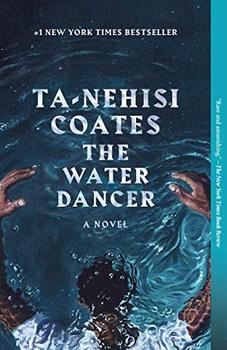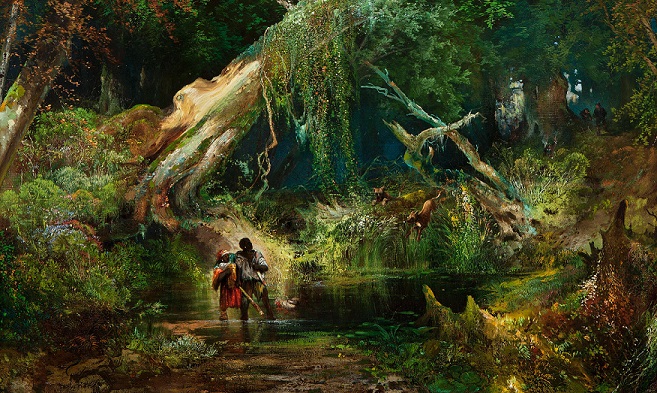Summary | Excerpt | Reviews | Beyond the Book | Read-Alikes | Genres & Themes | Author Bio

Critics' Opinion:
Readers' Opinion:
First Published:
Sep 2019, 432 pages
Paperback:
Nov 2020, 432 pages
 Book Reviewed by:
Book Reviewed by:
Dean Muscat
Buy This Book
This article relates to The Water Dancer
 A central storyline in Ta-Nehisi Coates' novel The Water Dancer focuses on slaves attempting to flee the South to the free states of the North. Many runaways had to endure long journeys on foot and unimaginable dangers along the way, including the high-risk possibility of being re-captured and returned to their owners to be severely punished in an effort to deter others from following suit.
A central storyline in Ta-Nehisi Coates' novel The Water Dancer focuses on slaves attempting to flee the South to the free states of the North. Many runaways had to endure long journeys on foot and unimaginable dangers along the way, including the high-risk possibility of being re-captured and returned to their owners to be severely punished in an effort to deter others from following suit.
Despite the hazards, there were successful escapes. Some slaves managed to find their way North. Others found refuge in the marshlands of the Great Dismal Swamp, which borders Virginia and North Carolina. This fugitive community of Great Dismal Swamp maroons is said to have numbered in the thousands and lasted until the end of the Civil War in the 1860s.
Researchers who have studied the area have found evidence to suggest the swamp was first used as an African American slave refuge from 1680, when America was still a British colony. From then, the community grew to also include Native Americans, white indentured servants, and others who felt persecuted and needed to escape societal norms.
 The swamp itself spanned some 1 million acres of wetlands and was filled with prickly briar bushes and water-logged ground. At the time, the area was also home to deadly animals including snakes and bears. While these harsh conditions made living here perilous, they also ensured the community was kept well-hidden and protected from pursuers.
The swamp itself spanned some 1 million acres of wetlands and was filled with prickly briar bushes and water-logged ground. At the time, the area was also home to deadly animals including snakes and bears. While these harsh conditions made living here perilous, they also ensured the community was kept well-hidden and protected from pursuers.
The maroon community made homes on concealed mesic islands, the high and dry parts of land deep within the swamp. These islands were so concealed, that their very existence wasn't discovered by historians and archeologists until many years later. Slave catchers were in fact too afraid to venture this deep into the swamp. The Great Dismal Swamp also formed part of the Underground Railroad, a network of secret routes and safe houses used by runaways heading to the Northern states.
Isolated as they were, the maroons became self-sufficient, establishing farming practices and making things by hand using the natural resources around them. There's also evidence to suggest that some groups would raid small towns in search of supplies and food. Research excavations on the main island have dug up fragments of handmade bowls and pipes, and even gun flint. They also found remains of post holes that supported numerous wooden cabins. Strangely, human remains have yet to be discovered, possibly indicating there are unknown burial grounds somewhere in the swamp, or, as some have posited, remains have disintegrated by the acidic water.
During the Civil War, some of the maroons formed guerrilla groups and began attacking Confederate troops. This led to the discovery of their secret base. Once the war ended however, the slaves were freed and eventually began abandoning the swamp.
Part of the history of the Great Dismal Swamp maroons was chronicled by Harriett Beecher Stowe in her 1856 novel Dred: A Tale of the Great Dismal Swamp.
What remains of the swamp is now a national wildlife refuge spanning 112,000 acres in southeastern Virginia/northeastern North Carolina. It is open to visitors and boasts a diverse ecosystem of hundreds of bird species, butterflies and mammals of all shapes and sizes.
"Slave Hunt in the Great Dismal Swamp by Thomas Moran, 1862, courtesy of 99% Invisible
Photo of Great Dismal Swamp National Wildlife Refuge, taken by Davina (BookBrowse editor) on 2018 visit.
Filed under Nature and the Environment
![]() This "beyond the book article" relates to The Water Dancer. It originally ran in October 2019 and has been updated for the
September 2019 edition.
Go to magazine.
This "beyond the book article" relates to The Water Dancer. It originally ran in October 2019 and has been updated for the
September 2019 edition.
Go to magazine.




Great political questions stir the deepest nature of one-half the nation, but they pass far above and over the ...
Click Here to find out who said this, as well as discovering other famous literary quotes!
Your guide toexceptional books
BookBrowse seeks out and recommends the best in contemporary fiction and nonfiction—books that not only engage and entertain but also deepen our understanding of ourselves and the world around us.